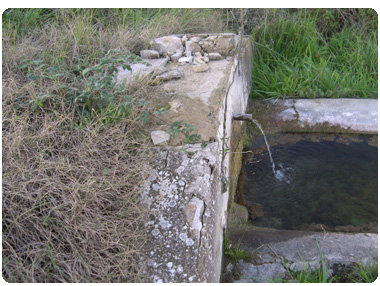 |
It’s almost
a year since we inaugurated our museum, so we decided to visit again two
of the most important archaeological sites we had already written about –
the probable and still unearthed site of an ancient Roman township, at
Pratola of Tressanti rural district (in Montecalvo Irpino territory); and
the most important excavation of Aequum Tuticum, at Sant’Eleuterio rural
district (in Ariano Irpino territory).
As regards the first of them, we only say that we have now a photographic
evidence regarding the vandalic destruction of the stone tablet at the
head of a rural fountain on which was engraved a Latin epigraph, a very
precious one for the historic information it handed down to us (see
Photogallery and the first item in The Index).
As regards Aequum Tuticum, we already knew, as we were approaching its
site, that the “plough/archaeologist” had once again dug up an artefact, a
thing rarely occurring there as a result brought about by the official
human archaeologists’ endeavour. The finding is just now kept secret, but
we were informed about it thanks to an Arianese cultural association’s
tract. That is, that a tractor had dug up a square limestone base with, on
one of its faces, a Latin epigraph tracing back its origin to the times
when Aequum Tuticum had become a Roman vicus (a village). The Latin
epigraph states the villagers’ gratitude to a certain Quinto Gagilio, who
had lavished a “perpetual” donation of money to them, in return for their
devotional rites to the memory of his son Quinto Gagilio Modesto, untimely
dead.
But there were other things on the premises which demonstrated to us how
the site was cared about. First, the information notice for visitors was
lying discarded at outskirts of the tilled soil around the site (see
Photogallegy); and second, the notice informed only briefly on Aequum
Tuticum’s past as a Roman vicus, ignoring altogether its prehistoric and
historic relevance, first, as a most important station along the
thanshumance trail connecting the Abruzzi mountains to the Apulia plain;
and later on, as a southern capital of the Samnite federation, as
suggested by the most learned historians, such as E.T. Salmon (see the
Essential Bibliography).
The meaning of the adjective tuticum is “pertaining to the touto”, an
Oscan word for “people”, which is analogous to the Latin populus, whose
legal and political meaning was “the gathering of all the free men bearing
arms”. An analogous place to Aequum Tuticum was the Campus Martius, in
Rome. Consequently, a clear translation of Aequum Tuticum is “the plain,
or the open space (this is the meaning of Aequum) where the Samnite tribes,
the local Hirpini included, gathered their federate forces to wage war,
subscribe peace, and at the same time, seek their magistrates/priests’ (meddices)
vaticination.
|


